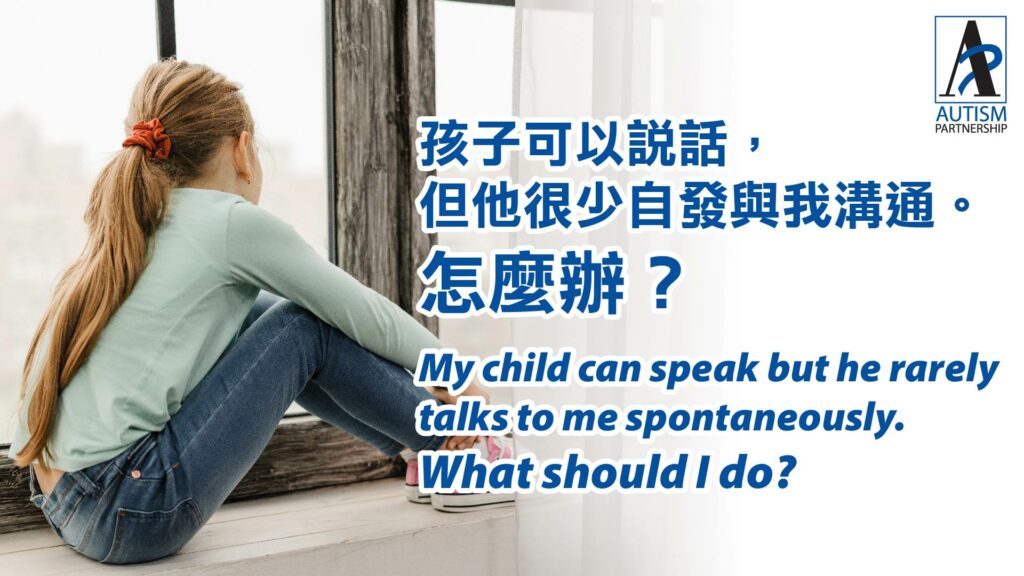
Lack of initiation to communicate is a core issue in individuals with ASD with various levels of language ability and various functioning levels. Although some autistic children have age-appropriate language skills, it’s typical for them to talk to others only when they need to fulfil own needs like requesting items and asking for help, rather than communicating for social purposes. And it causes parents always find them quiet and passive, and sometimes feel frustrated as they repetitively ask them questions, wishing them to share their feelings, thoughts and opinions. Some strategies are listed as below for your reference.
One strategy to increase spontaneous speech at home is to create needs and obstacles that our children cannot fulfil or solve by themselves. It is often the case that our children are very independent to complete routines and chores without asking for assistance. Therefore, from time to time, we need to create noticeable disruptions in routines, for example hiding one shoe away, no water in his/her cup, and giving mismatched socks to the child, and guide them to say the right words to you to fix the problem. When they can spontaneously say the right words, we can teach them different words or sentence structures to ask for the same type of assistance, or we can create new needs or problems that they need to solve.

We can also tempt children to comment on absurdities and asking why things have gone wrong or different. For example, playing their favourite movie with a different language, preparing a special snack box for school, putting a birthday cake out without announcement, etc. When they are aware of these differences and comment on or ask about them spontaneously, it’s necessary to give a consequence that is meaningful to the children to reinforce their responses, like adding a snack of their choice to the special snack box, and having a bigger slice of the birthday cake.

Another way to facilitate spontaneous language is to create novelty in various situations. Placing a new book in his school bag, downloading a new game on his electronic devices, putting a new snack in the snack box may elicit curiosity in children and tempt them to comment or ask questions.

Beside manipulating the environment, when a child makes a request, ask for assistance or ask us a question, we can try giving an unexpected response to them, or playing “dumb” to tempt them to make a further response. For example, we can deliberately get a wrong item after their requests, do a wrong action after they ask for help, or answer a question in a fun or silly way, like using a different voice or giving a wrong and funny answer.

Lastly, play is essential to increase spontaneous language. Unlike teaching play skills, real play should involve letting the child to explore and to lead the activity. When appropriate, parent can join in and model comments, initiate dialogues, and encourage children to do the same and reward them with more exciting and fun ways of playing.

Every little life is a special present for a family. From the time a baby is born, parents journey through lots of highs and lows, wishing for their child to grow up with a big smile, make great friends, find their own way in a job they love, and create a happy family. However, for […]

Autism Spectrum disorder can be diagnosed as early as 18 months. Research shows strong evidence on how effective Applied Behavior Analysis (ABA) can help children with Autism. It helps to deal with children’s challenging behaviors such as inattention, aggression, self-stimulation, etc. Howard, et al (2005) conducted a study to compare the effectiveness of 3 treatment […]

In today’s society where information flows freely, parents can easily receive different messages. However, these messages are often debatable or even wrong. Believing wrong information can easily lead to misguided choices and delay treatment, the consequences of which may last a lifetime. When conducting one-on-one consultations with parents, I often hear the following misguided views […]
Please share to let more people learn about ASD and ABA therapy:
AP holds the belief that with quality Autism Partnership Method (APM) treatment, individuals with autism should reach their fullest potential and achieve the greatest degree of independence and highest quality of life possible.

Sign up now to get ABA and Autism related news delivered to your inbox. Enter your email to get started
Hong Kong Center
Kowloon Center

All information received will always remain confidential. We will contact you as soon as we review your message. Thanks